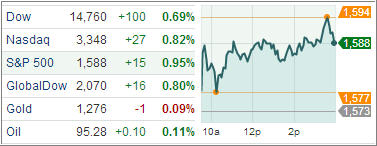Bulls got some much needed fuel to push U.S. equity markets higher, the most in nearly two weeks thanks to a slew of upbeat domestic economic reports. The Dow Jones Industrial Average rose 101 points (0.7%) to 14,760; the Standard & Poor’s 500 Index rebounded from a nine-week low, added 15 points (1.0%) to 1,588, while the Nasdaq Composite gained 27 points (0.8%) to 3,348.
U.S. stocks climbed today as the Conference Board’s index of U.S. consumer confidence rose 7.1 points in June, its third straight gain, to 81.4, the highest level since January 2008 . Economists expected the index would decline 0.7 points to 75.5.
Consumers remain upbeat despite higher payroll and income taxes this year and the negative impact from the government sequester. The current confidence level is allegedly consistent with the trend in economic growth. Elsewhere, new home sales rose 2.1% to a 476,000 unit annual rate, the highest level since July 2008. Economists expected a 1.8% gain to a 462,000 unit rate. On a y/y basis, sales are up 29.0%. With sharply rising mortgage rates, I have to wonder how long that will last.
Meanwhile, the S&P/Case-Shiller 10-city and 20-city composite home price indexes rose for the 15th straight month in April, up 1.8% and 1.7%, respectively. On a y/y basis, prices are rising near 12%, the fastest pace since March 2006.
Finally, durable goods orders rose 3.6% in May, above the consensus of 3.2%. The gain was led by a 51.0% surge in civilian aircraft. Excluding transportation, orders picked up 0.7%. Nondefense capital goods ex-aircraft orders rose 1.1%, its third gain in a row, as most major categories advanced. The capex book-to-bill ratio rose to 102.2%, the highest level in over a year, indicating factory activity is picking up.
The majority of today’s advance occurred in the first 90 minutes of the session amid a global rebound. Notably, China’s Shanghai Composite shed only 0.2% after being down as much as 5.7%. The rally off the lows unfolded amid speculation The People’s Bank of China will step in to resolve the ongoing liquidity crisis. On a related note, U.S. Treasuries were in demand overnight, but surrendered all of their gains shortly after the open. As a result, the benchmark 10-yr yield ended higher by four basis points at 2.589%.
Also of note, the utilities space advanced 1.2% to trim its June loss to 1.1%. Other defensive sectors trailed behind the broader market as consumer staples tacked on 0.1% while health care added 0.4%. Meanwhile, cyclical groups were led by a 1.9% gain in financials.
As I posted yesterday, after the recent sell-off, a rebound of some sort was pretty much a certainty, but the question remains if today was simply a dead cat bounce with the downside coming into play again.
Our Domestic Trend Tracking Index (TTI) inched back up from yesterday’s negative -0.31% position and crossed the line to the bullish side by a meager +0.13%. We may see some more meandering around the trendline, so, in order to avoid any potential whipsaw signals, I will need to see a clear break below it before declaring this bull market to be over. Until this moment arrives, use your trailing sell stops to make your exit decisions.
The International TTI headed higher as well and ended the day at +1.73%.
Contact Ulli

Comments 4
Wait a second. I thought on Monday it was clear the signal was a SELL. I thought you would say just because TTI is now 0.13, does not mean we are back in BUY mode. But now I’m reading you never gave a SELL.
Confused, since the language you used in previous post about TTI crossing below ZERO seemed to indicate one either treats this as a SELL signal or use stop loss to guide exit.
Rash,
When we are close to a crossing of the trend line, either up or down, there is always the danger of a whipsaw signal. To minimize that occurrence, I don’t give a sell or buy signal until the trend line has been clearly pierced.
Since that was not the case with a meager -0.31% break, I recommended that you continue to use your trailing sell stops (for domestic holdings) as a guide to exit.
Ulli…
Ulli,
Further to Rash’s comments, if you got a new client on Monday with 200K to invest and his risk was normal to aggressive can you please explain what you would do with the money BUY, HOLD, Sell short (purchase inverse ETFs) as the Domestic slipped below the TTI.
This is the flaw in (Turtle) or any trend following. It is portrayed as mechanical but in actuality it is really judgmental.
This is not a reflection on you as your information is great and you are also a very successful financial professional with a profitable strategy. This same issue happened about a year ago as the price slipped down below or touched the TTI line but then went back up. Its subjective in the end. It is interesting to read where Rash’s perception was 180 degree from yours.
TR,
Of course, going strictly mechanical is not the way to go, as I have posted from time to time, especially when major trends change and whipsaws are a possibility. There has to be some active management at times, or as I like to call it “subjective reasoning.” I have repeatedly made that point when a trailing sell stop gets triggered. The idea is not to blindly sell the next day, but to observe if a market rebound is in the making, which always causes me to hold off another day.
Same applies for trend line crossings.
Ulli…